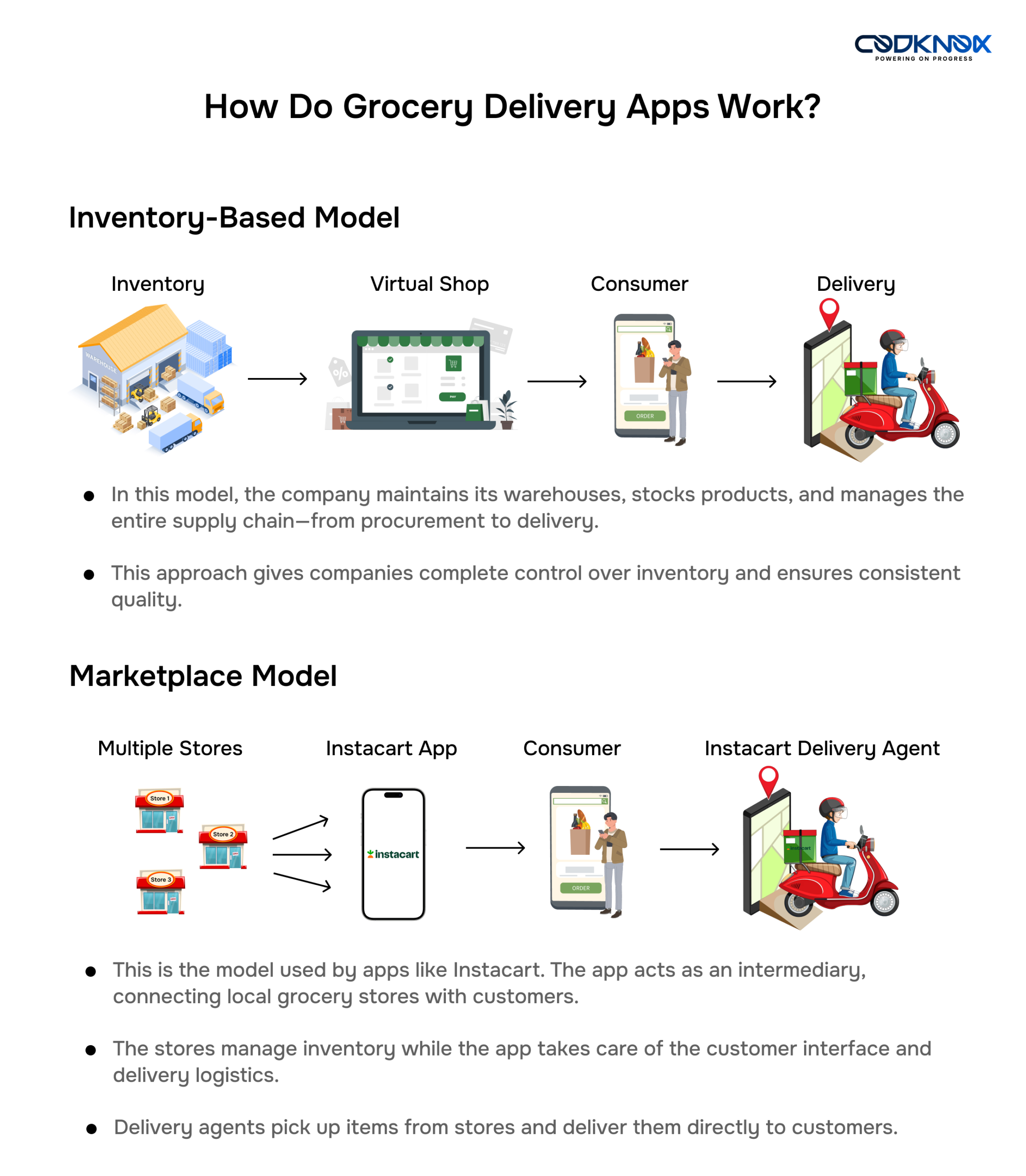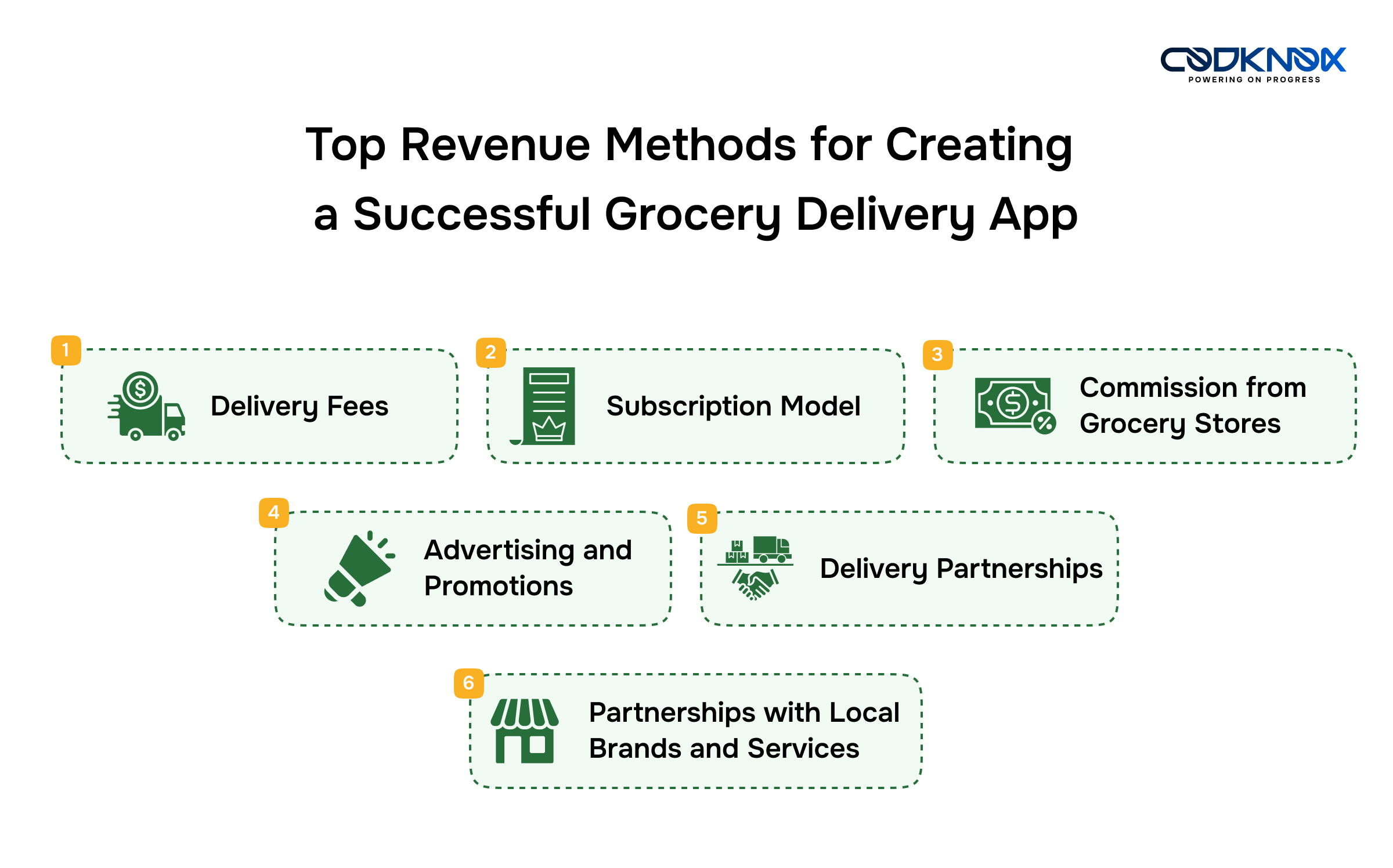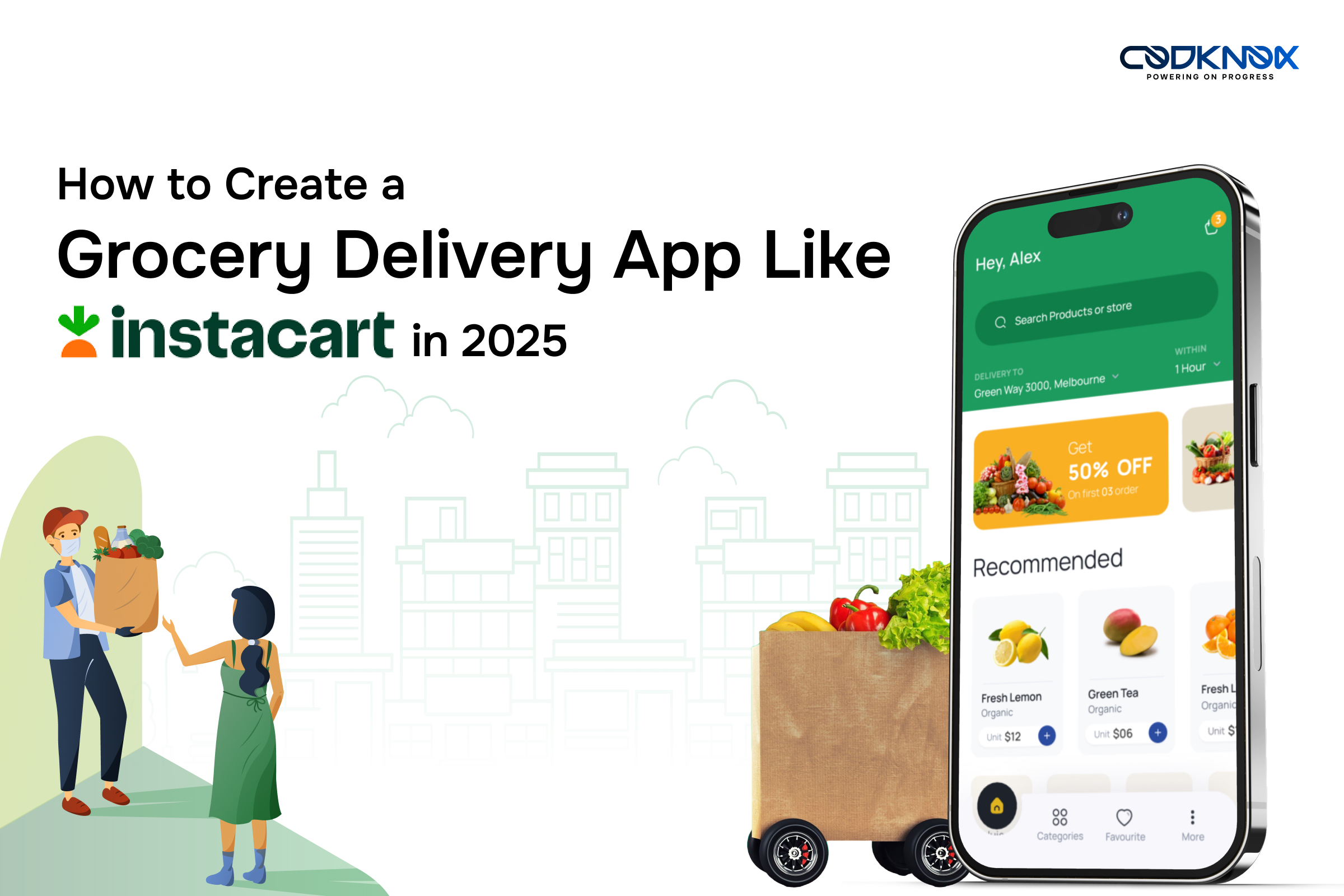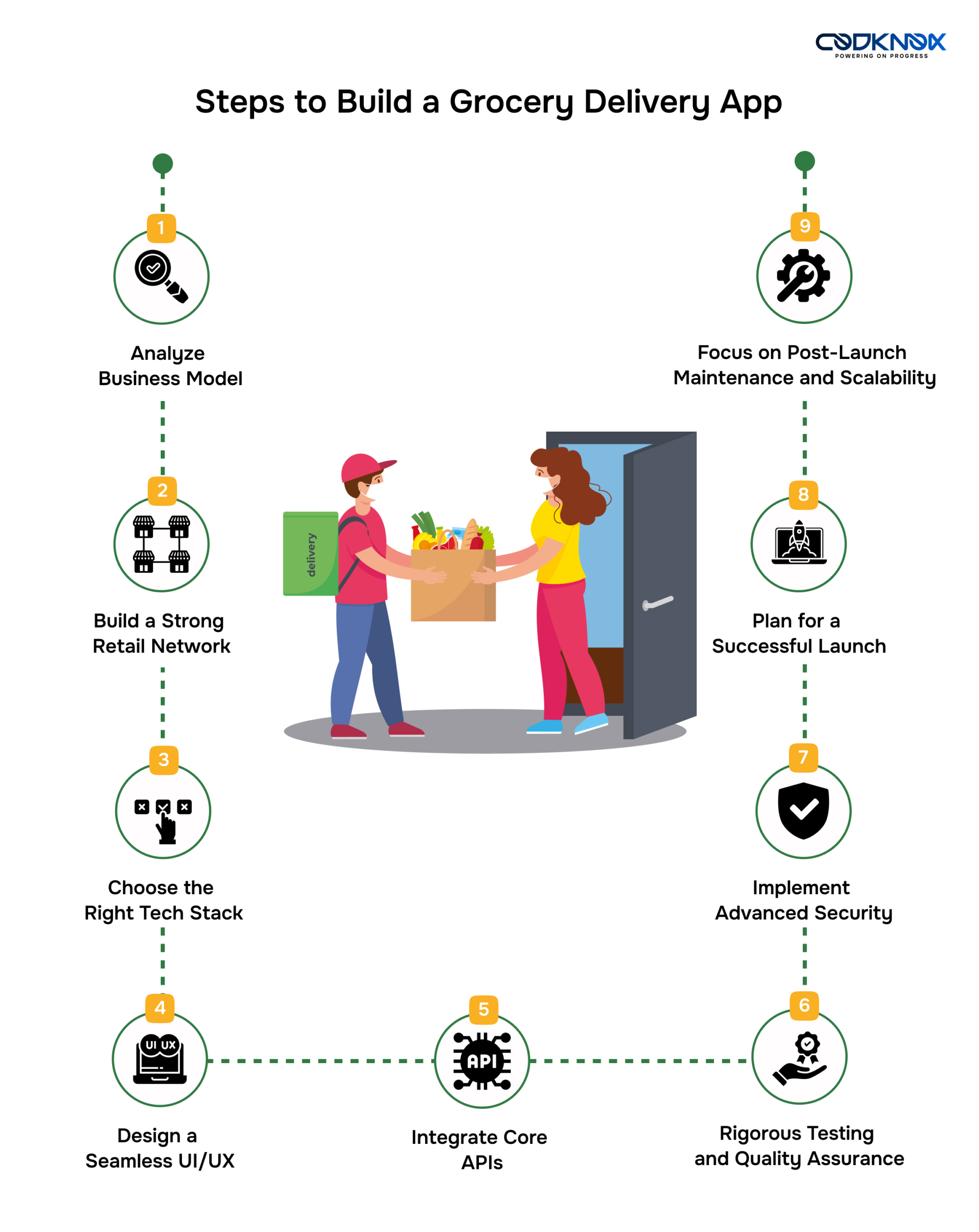The grocery delivery industry has witnessed unprecedented growth in recent years, with apps like Instacart leading the way. In a world where convenience reigns supreme, creating a grocery delivery app has become a lucrative business opportunity.
If you’re considering entering this space, this guide will provide you with the essential steps and insights into a successful grocery delivery app development solution in 2025.
How Do Grocery Delivery Apps Work?
Grocery delivery apps generally operate on two distinct models: the inventory-based system and the marketplace platform.
Here’s how these models work:

Why Build a Grocery Delivery App in 2025?
The demand for grocery delivery services is set to grow exponentially in the coming years. Factors like busy lifestyles, increasing smartphone penetration, and a preference for contactless shopping drive this trend. By investing in a grocery delivery app development solution, you can tap into a lucrative market and offer a valuable service to your customers.
The grocery delivery industry has experienced remarkable growth in recent years, with apps like Instacart leading the way. In 2023, Instacart’s sales totaled $35.2 billion, marking a 15% increase year-over-year. (Capital One Shopping)
Projections indicate that by 2026, 59.4% of online grocery sales will be for delivery. (Capital One Shopping)
Globally, the online grocery market is expected to grow at a compound annual growth rate of 26.8% from 2022 to 2030, reaching USD 305.13 billion by 2030. (Grand View Research)
If you want to speak with an experienced team of grocery delivery app developers to gain clarity on the grocery app development ideas, we can help.
Steps to Build a Grocery Delivery App
Creating a successful grocery delivery app requires a systematic approach. Empower your grocery delivery app development with these steps to deliver a high-performing, user-focused solution.
1. Analyze the Business Model for Grocery App Development
For successful grocery shopping app development, it’s crucial to understand the underlying business dynamics.
- Revenue Streams: Identify how your app will generate income, such as through commissions from grocery stores, delivery fees, subscription plans, or memberships.
- Target Audience: Research the demographics, preferences, and pain points of your potential users to tailor the app’s features accordingly.
- Partnerships: Analyze how leading apps like Instacart collaborate with grocery retailers, delivery agents, and logistics partners. These relationships are critical for smooth operations.
2. Build a Strong Retail Network
A diverse product offering is key to user satisfaction. Collaborate with local grocery stores, supermarkets, and specialty shops to ensure product variety. Develop systems to manage inventory updates, order synchronization, and delivery timelines with partnered retailers. Also, establish strong partnerships with retailers to negotiate favorable terms and ensure priority services during high demand.
3. Choose the Right Tech Stack for Grocery App Development
The technology stack determines the app’s scalability, performance, and speed. Use front-end frameworks like React Native or Flutter for a smooth user interface and back-end technologies like Node.js or Python for robust operations. Decide whether to develop the app from scratch for flexibility or use ready-made frameworks for faster deployment. Opt for cloud-based services to handle storage and scale seamlessly as your user base grows.
4. Design a Seamless UI/UX for Grocery Shopping App Development
A user-centric design is non-negotiable. Ensure the app is easy to navigate, with clear categories, search functionalities, and simple checkout processes. Use clean, visually engaging designs that make browsing enjoyable while maintaining a professional aesthetic. Incorporate features like voice search or large text options to cater to a broader audience.
5. Integrate Core APIs
Core APIs enable vital app functionalities. Integrate secure and popular payment methods like credit cards, digital wallets, and UPI. Allow users to track their orders live with GPS integration. Include chat or notification systems for seamless communication between customers, delivery agents, and retailers.
6. Rigorous Testing and Quality Assurance
A bug-free grocery delivery app development solution improves user satisfaction and retention. Test the app on multiple devices and operating systems to ensure a seamless experience for all users. Conduct functional, performance, and security testing to identify bottlenecks and improve performance. Create real-world scenarios to test app behavior under high traffic or unusual conditions.
7. Implement Advanced Security
Users must feel their data is safe. Encrypt sensitive user data like payment details, addresses, and personal information to prevent breaches. Follow data protection laws like GDPR or CCPA to avoid legal complications. Implement multi-factor authentication to secure accounts and transactions.
8. Plan for a Successful Launch
A well-planned launch can set the tone for your app’s success. Release a beta version to a limited audience to gather feedback and refine features. Use targeted advertising, social media promotions, and influencer endorsements to create buzz before the launch. Start with a city or region-specific rollout before expanding to larger markets.
9. Focus on Post-Launch Maintenance and Scalability
Launching the app is just the beginning; continuous improvement is necessary. Use analytics tools to track performance, user behavior, and feature usage to identify areas of improvement. Roll out updates with new features and enhancements based on user feedback and market trends. Upgrade servers, APIs, and backend infrastructure as the user base grows to ensure smooth operation without downtime.
Key Features Inspired by Instacart for Your Grocery App Development
For a grocery delivery app development solution inspired by Instacart, it’s essential to incorporate features that enhance user experience, streamline operations, and offer both convenience and flexibility. Here are the key features to consider.
- User-Friendly Interface: The app should have a clean and intuitive design, allowing users to easily browse categories, search for specific items, and navigate without any confusion.
- Real-Time Tracking: Track orders and deliveries in real-time, from the moment the customer places an order to when the grocery is delivered. This feature helps users stay updated on delivery times and allows them to plan accordingly.
- Personalized Recommendations: Offer product suggestions based on past purchases and browsing history. Use AI-powered algorithms to recommend items that a user may be interested in, increasing the likelihood of additional purchases.
- Multiple Payment Options: Integrate a wide range of payment methods, including credit/debit cards, digital wallets like Apple Pay and Google Pay, and other local payment methods. This ensures a seamless transaction experience for all customers.
- In-App Grocery Lists: Enable users to create and save grocery lists for future orders. These lists can be quickly accessed, modified, and ordered with just a few taps, making it easier for customers to shop regularly.
- Flexible Delivery Options: Allow users to choose from various delivery options—same-day delivery, scheduled deliveries, or express delivery. This ensures flexibility for customers with different needs.
- Subscription Services: Offer a subscription model, like Instacart’s “Instacart Express,” where users can pay a monthly or yearly fee for benefits like free delivery and reduced service fees on orders.
- Store-Specific Deals and Discounts: Provide users with special offers, discounts, and promotions from specific grocery stores. This not only attracts customers but also encourages them to shop more frequently.
- Real-Time Communication: Enable chat or call functionality so users can communicate directly with their delivery drivers or customer support if they encounter any issues or have specific delivery instructions.
- Order History and Reordering: Allow users to easily view and reorder items from their previous orders. This is especially useful for items that are regularly purchased, such as household goods or groceries.
- Ratings and Reviews: Incorporate a system for customers to rate and leave reviews for stores and delivery services. This helps build credibility and trust with new users while providing valuable feedback for improvement.
- Multi-Language Support: To cater to a diverse customer base, offer multi-language support in the app, allowing users to select their preferred language for a more personalized experience.
- Push Notifications: Keep users engaged with real-time alerts about order status, promotions, new product arrivals, or personalized offers based on their shopping habits.
- Geolocation and Mapping: Integrate GPS and mapping features to show users the closest grocery stores available, track delivery drivers, and provide accurate delivery estimates.
- Customizable Delivery Windows: Allow users to choose specific delivery windows that fit their schedule, ensuring maximum convenience and satisfaction.
What Are the Best Ways to Monetize a Successful Grocery Delivery App?

- Delivery Fees: Charge a standard or variable delivery fee per order, or offer express delivery for a premium.
- Subscription Model: Offer users a subscription service with benefits like free delivery, discounts, or exclusive deals.
- Commission from Grocery Stores: Earn a commission on each sale made through the app from partnered grocery stores.
- Advertising and Promotions: Display in-app ads or offer sponsored listings and promotions for grocery brands or local businesses.
- Delivery Partnerships: Partner with third-party delivery services or manage your own fleet, charging a fee for the logistics.
- Partnerships with Local Brands and Services: Cross-promote with local businesses, allowing them to pay for inclusion in the app or share a portion of the sales.
Why Trust Your Grocery App Development to Experts?
In-house grocery shopping app development can be a daunting task. It requires assembling a team of specialized developers, handling infrastructure management, and staying up-to-date with the latest technologies. These challenges can be both time-consuming and costly, making it difficult to focus on the core aspects of your business.
Modern grocery shopping app development demands specific expertise. Without the right knowledge, internal development can quickly become a burden, increasing both startup costs and complexity.
At CodKnox, we bring years of experience in building robust digital solutions. Our team is proficient in mobile and web technologies, making us the ideal partner for creating scalable food delivery platforms. We help businesses navigate common development pitfalls like high initial investments and intricate infrastructure management.
By partnering with Codknox, you’ll have access to a dedicated team of grocery delivery app developers who understand the unique needs of grocery delivery systems. We focus on delivering practical, high-quality solutions that are backed by our deep technical expertise.
If you would like to book a no-cost consultation session with us, please share your details in the form to your right.

